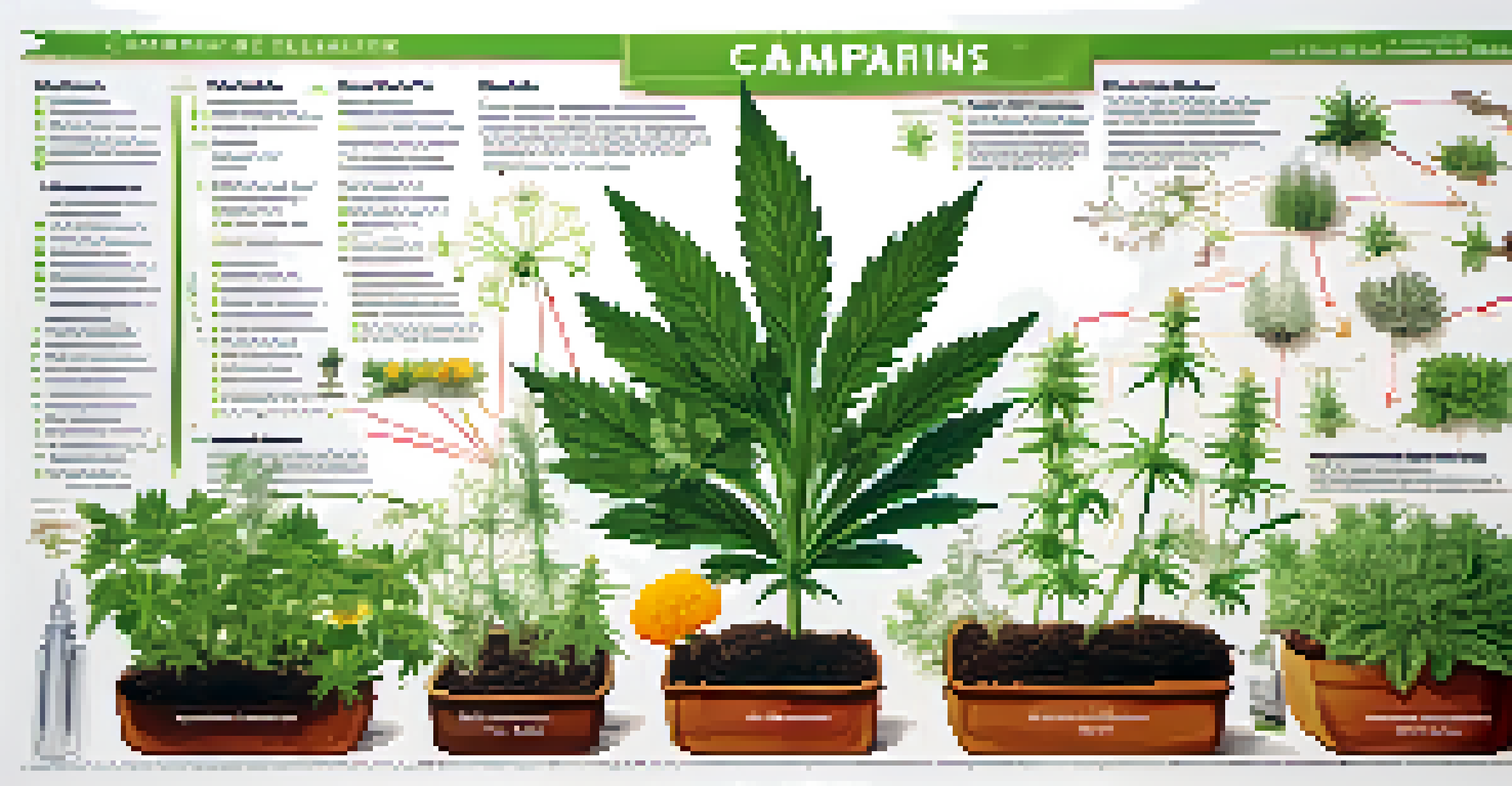Exploring Companion Planting Techniques for Cannabis Growth

What is Companion Planting and Why Use It?
Companion planting is the practice of growing different plants together to enhance growth, deter pests, and improve flavor. It’s like having a supportive friend; certain plants can help others thrive by providing nutrients or shielding them from harmful insects. This technique is particularly useful in cannabis cultivation, where maintaining plant health is essential for high yields.
The best way to ensure a successful garden is to grow plants that help each other thrive.
By strategically choosing companions, you can create a mini-ecosystem that benefits all plants involved. For example, planting basil alongside cannabis can repel pests while enhancing the aroma of your cannabis plants. Understanding these relationships can lead to healthier plants and a more abundant harvest.
In essence, companion planting is a natural approach to gardening that minimizes the need for chemical pesticides and fertilizers. It allows growers to tap into nature’s wisdom, creating a sustainable growing environment that can lead to better quality cannabis.
Benefits of Companion Planting for Cannabis Cultivation
The benefits of companion planting extend beyond just pest control. For cannabis, these techniques can enhance growth rates, improve soil health, and even boost flavor profiles. When plants are grown alongside compatible companions, they can share resources, leading to stronger and more resilient crops.

Another significant advantage is pest management. Certain plants, like marigolds, emit scents that deter harmful insects while attracting beneficial ones, like pollinators. This natural pest control reduces the need for chemical interventions, which can harm the cannabis plants and the environment.
Enhance Growth with Companion Plants
Companion planting promotes healthier cannabis by enhancing growth rates and improving soil health through beneficial plant relationships.
Additionally, companion plants can improve soil structure and health. For instance, legumes can fix nitrogen in the soil, making it more nutrient-rich for cannabis. This symbiotic relationship not only benefits the cannabis but can also enhance the overall biodiversity of your garden.
Choosing the Right Companion Plants for Cannabis
Selecting the right companions is crucial for effective companion planting. Some popular choices for cannabis include basil, cilantro, and mint, each offering unique benefits. For example, basil not only deters pests but can also enhance the flavor of your cannabis, making it a favorite among growers.
Companion planting is not just a technique; it's about creating a balanced ecosystem that benefits all plants.
Conversely, some plants can be detrimental to cannabis growth. For instance, planting cannabis near fennel can inhibit its growth due to chemical interactions in the soil. It’s essential to research and understand which plants harmonize well together to maximize the benefits of companion planting.
By creating a diverse planting scheme, you can foster a healthier environment for your cannabis. This diversity not only supports plant health but can also attract beneficial insects that aid in pollination and pest control, leading to a more productive garden.
Companion Planting Techniques for Pest Control
One primary goal of companion planting is effective pest control. By incorporating plants that act as natural repellents, you can protect your cannabis from common pests like aphids and spider mites. For example, planting garlic or chives can deter harmful insects while promoting a healthy growing environment.
Another technique is intercropping, where you alternate rows of cannabis with companion plants. This method can confuse pests and make it difficult for them to locate their preferred host plants. The variety in your garden can lead to a natural balance, reducing the likelihood of pest infestations.
Natural Pest Control Strategies
Using companion plants like marigolds and garlic provides effective natural pest control, minimizing the need for chemical interventions.
Lastly, consider using trap crops, which are plants specifically grown to lure pests away from your cannabis. For instance, planting radishes can attract pests that would otherwise target your cannabis, providing a sacrificial layer of protection. This strategy not only safeguards your primary crop but also supports a more resilient gardening ecosystem.
Enhancing Nutrient Availability with Companion Plants
Companion plants can enhance nutrient availability in the soil, benefiting your cannabis significantly. Some plants, like clover, are known to fix nitrogen, enriching the soil for neighboring plants. This natural fertilization process can lead to healthier cannabis plants with improved growth rates and yields.
Additionally, deep-rooted plants can help access nutrients that are otherwise unavailable to shallow-rooted cannabis. By planting varieties with different root depths, you create a more dynamic soil structure that maximizes nutrient uptake. This synergy can result in stronger, more vigorous plants.
Moreover, the organic matter from companion plants, when decomposed, can improve soil structure and moisture retention. This contributes to a healthier growing environment for cannabis, reducing the need for synthetic fertilizers and enhancing the overall quality of your crop.
Soil Health and Microbial Activity Through Companion Planting
Healthy soil is the foundation of successful cannabis growth, and companion planting can significantly improve soil health. By introducing a variety of plants, you enhance the microbial diversity in the soil, which plays a crucial role in nutrient cycling and plant health. This diversity can lead to a more resilient garden ecosystem.
Certain companion plants can attract beneficial microbes that improve soil fertility and structure. For instance, plants like yarrow boost microbial activity, promoting a thriving environment for cannabis roots. Healthier soil translates to healthier plants, ultimately leading to a more productive harvest.
Boost Soil Health and Nutrients
Diverse companion plants improve soil structure and nutrient availability, creating a sustainable environment for stronger cannabis growth.
Additionally, the organic matter from decaying companion plants serves as a natural fertilizer, enriching the soil over time. This ongoing cycle of growth and decomposition fosters a sustainable gardening approach that supports both soil health and cannabis production.
Practical Tips for Implementing Companion Planting
To get started with companion planting, begin by selecting a small area of your garden to experiment. Choose a few compatible plants to introduce alongside your cannabis, such as basil or marigolds. Observe how they interact and take notes on any changes in pest activity or plant health.
Make sure to space your plants properly to allow for growth and airflow. Overcrowding can lead to competition for resources and increased vulnerability to pests and diseases. A well-planned garden layout can significantly enhance the effectiveness of companion planting.

Lastly, monitor your garden regularly to assess the impact of your companion plants. Adjust your planting strategy based on what works best for your specific environment. This hands-on approach will help you refine your skills and optimize your cannabis cultivation through companion planting.